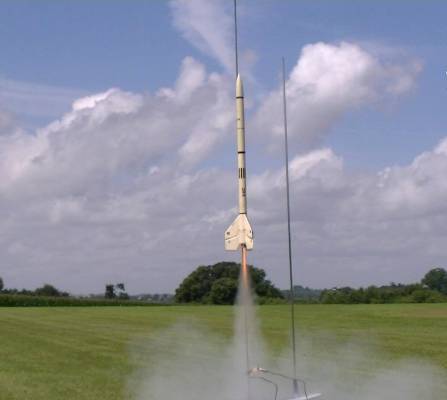The Beta: I love this little gem, but I haven't been able to get T sized booster motors any more.
UPDATE: Estes is now making them again - I have some due to arrive shortly! Yea!!!!!
I think the small size of this rocket combined with its high-altitude capabilities is better off with a bright Mylar streamer instead of the 10" parachute. This makes it easier to spot in the air and on the ground, and reduces drifting in the wind. This rocket was recently given my "Iris" modification, which extends the body tube about 5 inches above the streamer/parachute bay, and allows for a payload with an Altimeter One to measure altitudes. The A-power booster and A-power sustainer really lift this Beta high, over 700 feet on just two A's! I'd say that's pretty good proof that multi-stage rockets are more efficient with propellant, as the same mass of propellant made into a single B-motor would have topped-out at about 500 feet.
After a flight where the second stage did not light for unknown reasons, the Beta was badly damaged. It was repaired with a new and shorter payload section, and the body tube was lengthened to fix the worn-down top of the tube. This rocket is now 19-7/8" long with both stages.
What's great about this kit is you can fly a two stage very economically, since T motors are cheaper than standard sizes. (Iris is named after the Greek god of the rainbow. She is a messenger of the gods, linking the gods with humanity.) This rocket has flown higher than the Revel Casino Towers in Atlantic City, and the Met-Life Tower in NY, and could very easily fly over the St. Louis Gateway Arch.
| Flight Date: | 2013-07-14 |
| Rocket Name: | Beta |
| Kit Name: | Estes - Beta {Kit} (845) [1972-1984] |
| Flyer's Name: | Rich DeAngelis |
| Motors: | A10-0/1/2A3-4 |
| Expected Altitude: | 435 Feet |
| Wind Speed: | 3.00 mph |
| Launch Site: | Penn Manor School Lancaster PA |
| Actual Altitude: | 440 Feet |
A great morning for flying, though it was quite warm and humid. This was the final test flight of the Beta Iris with a 1/2A sustainer. The booster lit without delay and the rocket took off quickly and straight up. Staging went well and appeared to be at about 200 feet.
The sustainer continued straight up, with a peak acceleration of 19.8 Gs, while the average for the flight was 4.7 Gs. The rocket reached a top speed of 106 mph, the slowest for this rocket.
Ejection occurred only 1/10 second early at 426 feet, but the rocket continued up an additional 14 feet in the next 7/10 seconds to apogee at 440 feet. This was the highest recorded altitude with a 1/2 A sustainer.
The little 8” chute opened well and the rocket returned at 8 mph to a soft, grass landing one or two hundred feet downwind. The booster had already fallen, and the booster’s casing blew out of the lower stage. Overall it was an excellent flight.
| Stage | Motor(s) |
|---|---|
| 1 | Estes A10T-0 |
| 2 | Estes 1/2A3T-4 |
 |
 |
